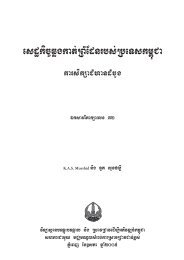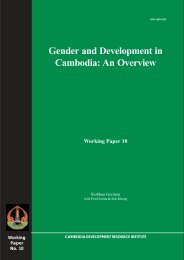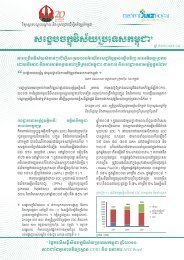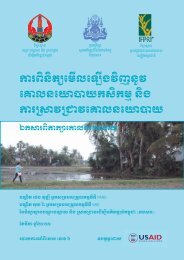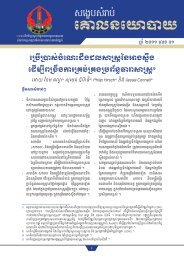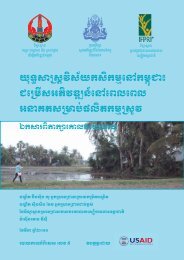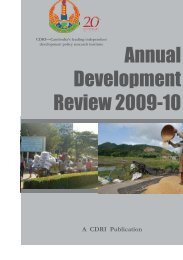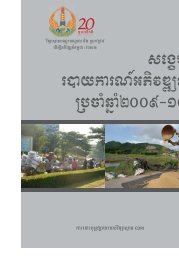Cambodia Country Study Working Paper Series No. 44 ... - CDRI
Cambodia Country Study Working Paper Series No. 44 ... - CDRI
Cambodia Country Study Working Paper Series No. 44 ... - CDRI
You also want an ePaper? Increase the reach of your titles
YUMPU automatically turns print PDFs into web optimized ePapers that Google loves.
CHAPTER 2<br />
2.1. Background<br />
EVOLUTION OF LABOUR<br />
EMIGRATION IN CAMBODIA<br />
In the last two decades migration has changed from the forced movement of<br />
refugees or displaced people along the <strong>Cambodia</strong>n-Thai border due to civil wars<br />
and political instability to voluntary migration in search of works. A wave of<br />
<strong>Cambodia</strong>ns migrating to work in Thailand has emerged in the last decade. There<br />
�����������������������������������������������������������������������������������������<br />
Thailand. There are basically two types of labour migrants: those who stay for months or<br />
years in Thailand and those who work in areas near the border, mostly in farming. The<br />
long-range migrants are engaged in construction, manufacturing, plantations, domestic<br />
�����������������������������������������������������������������������������������������<br />
H.E. Seng Sakda’s remarks at a workshop to discuss labour migration policy in <strong>Cambodia</strong><br />
����������������������������������������������������������������������������������������<br />
�����������������������������������������������������������������������������������<br />
Receiving countries have a demand for low-skilled labour due to their economic expansion<br />
����� ���� ����� �������� ���� ���� ������������ ����������� ��� ����� ����� ���� ������ �����������<br />
����������������������������������������������������������������������������������������������<br />
������������������������������������������������������������������������������������������<br />
����� ������� ����������� ���������� ����� ���������� ����� ���� �������� ������� �����������<br />
������ ����� ��� ���������� ������ ������������� �������� ����� ��������� ������� ��� �������<br />
east Asian nations (World Bank 2007). However, high growth is only one condition<br />
����������� ������� ���� �������� ��������� ����� ��������� ���� ������ ������ ��� ���������� �����<br />
low growth rates. Wage differentials and high mobility from low-end to upper occupations<br />
have contributed to labour shortages and mismatches in labour markets. Labour market<br />
��������������������������������������������������������������������������������<br />
<strong>Cambodia</strong>’s labour emigration has increased particularly since the mid-1990s, which were<br />
�����������������������������������������������������������������������������������������<br />
������ ������� ����� �� ���� ����������� �������� �������� ������ ����� ��� �������� ���������<br />
and Battambang provinces. At present, migrant workers come not only from these areas,<br />
which formerly received <strong>Cambodia</strong>n refugees returning from Thai border camps, but also<br />
come from many other provinces. Fewer migrants come from rural and remote areas, where<br />
communications and infrastructure are severely limited. Although Thailand continues to<br />
be the destination country of the largest number of migrants, other destinations include<br />
�����������������������������������������������������������������<br />
Table 2.1 suggests a clear relationship between national income and migration, but no<br />
relationship with size of population. The low-income countries are the sending countries,<br />
while high-income countries such as South Korea, Singapore and Japan receive unskilled or<br />
low-skilled workers as their labour force moves upward. The poor labour-sending countries,<br />
Laos, <strong>Cambodia</strong> and Nepal, also receive migrant workers from Vietnam, China and Thailand,<br />
15 <strong>CDRI</strong>



